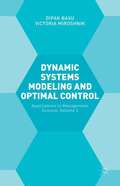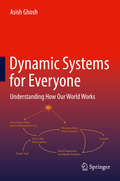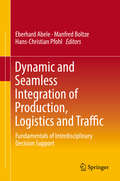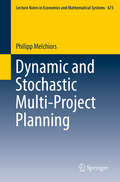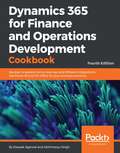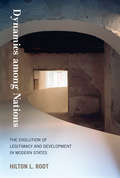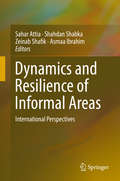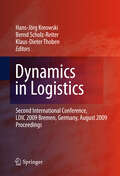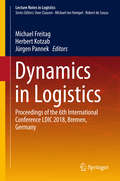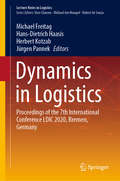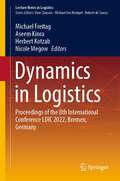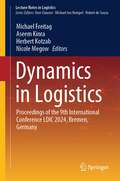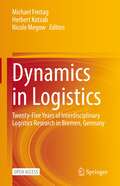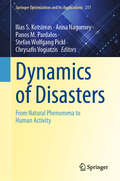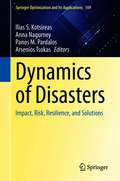- Table View
- List View
Dynamic Systems Modeling and Optimal Control: Applications In Management Science
by Victoria W. Miroshnik Dipak BasuDynamic Systems Modelling and Optimal Control explores the applications of oil field development, energy system modelling, resource modelling, time varying control of dynamic system of national economy, and investment planning.
Dynamic Systems Modelling and Optimal Control: Applications in Management Science
by Dipak Basu Victoria MiroshnikDynamic Systems Modelling and Optimal Control explores the applications of oil field development, energy system modelling, resource modelling, time varying control of dynamic system of national economy, and investment planning.
Dynamic Systems for Everyone: Understanding How Our World Works
by Asish GhoshSystems are everywhere and we are surrounded by them. We are a complex amalgam of systems that enable us to interact with an endless array of external systems in our daily lives. They are electrical, mechanical, social, biological, and many other types that control our environment and our well-being. By appreciating how these systems function, will broaden our understanding of how our world works. Readers from a variety of disciplines will benefit from the knowledge of system behavior they will gain from this book and will be able to apply those principles in various contexts. The treatment of the subject is non-mathematical, and the book considers some of the latest concepts in the systems discipline, such as agent based systems, optimization, and discrete events and procedures. The diverse range of examples provided in this book, will allow readers to:Apply system knowledge at work and in daily life without deep mathematical knowledge;Build models and simulate system behaviors on a personal computer; Optimize systems in many different ways;Reduce or eliminate unintended consequences;Develop a holistic world view .This book will enable readers to not only better interact with the systems in their professional and daily lives, but also allow them to develop and evaluate them for their effectiveness in achieving their designed purpose.Comments from Reviewers: “This is a marvelously well written introduction to Systems Thinking and System Dynamics - I like it because it introduces Systems Thinking with meaningful examples, which everyone should be able to readily connect” - Gene Bellinger, Organizational theorist, systems thinker, and consultant, Director Systems Thinking World “Excellent book ...very well written. Mr. Ghosh's world view of system thinking is truly unique” - Peter A. Rizzi, Professor Emeritus, University of Massachusetts Dartmouth “A thorough reading of the book provides an interesting way to view many problems in our society” –Bradford T. Stokes, Poppleton Chair and Professor Emeritus, The Ohio State University College of Medicine “This is a very good and very readable book that is a must read for any person involved in systems theory in any way - which may actually include just about everyone” - Peter G. Martin, Vice President Business Value Consulting, Schneider Electric
Dynamic Tourism
by Priscilla BonifaceThis book portrays a fresh approach to tourism. It argues for increased and radical change by the tourism industry and claims that this change is made necessary by the emergent sophistication and increased experience of tourists who require a different style of treatment and type of product. Dynamic Tourism is presented as a formula to meet the needs of the prevalent consumer society, to cater for its changing wishes, to reflect society's contemporary concerns and to accommodate the ongoing projected growth of tourism. The focus is upon the tourist, highlighting the need for the tourism industry to give greater consideration to tourists' changing needs, and to take a more flexible, modern and thought-out approach. The argument is delivered in three parts. First, the book indicates why Dynamic Tourism is needed as a method, and shows its first signs of appearing. It then delivers the detail and practicality of the process. Finally, the complete concept is outlined and the method of future implementation is projected. Examples from around the world are used to explain and illustrate the argument. Underlying the whole discussion is the recognition that the tourism arena is a resource of finite size, needing capacity for renewal and requiring the most intelligent, adaptable and considered use. The intended readership for this book includes all participants in the tourism experience: the tourism industry, its policy makers, operatives and stakeholders, and those students who intend to join their ranks, existing tourists who are disappointed with the limited provision offered to them at present and who wish for better in the future, along with the increasing number of new tourists whose outlook is very different from those of the past.
Dynamic and Seamless Integration of Production, Logistics and Traffic
by Eberhard Abele Manfred Boltze Hans-Christian PfohlThis book contributes a basic framework for and specific insights into interdisciplinary connections between production, logistics, and traffic subsystems. The book is divided into two parts, the first of which presents an overview of interdisciplinarity in value-added networks and freight traffic. This includes an introduction to the topic and a description of an integrated framework of production, logistics, and traffic. Furthermore, it describes the barriers and challenges of interdisciplinary decision-making and project management. In turn, the second part presents domain-specific perspectives on interdisciplinary decision support, exploring domain-specific challenges of interdisciplinary interfaces and requirements for management methods and instruments from the standpoint of production management, logistics management, traffic management, and information technologies.
Dynamic and Stochastic Multi-Project Planning
by Philipp MelchiorsThis book deals with dynamic and stochastic methods for multi-project planning. Based on the idea of using queueing networks for the analysis of dynamic-stochastic multi-project environments this book addresses two problems: detailed scheduling of project activities, and integrated order acceptance and capacity planning. In an extensive simulation study, the book thoroughly investigates existing scheduling policies. To obtain optimal and near optimal scheduling policies new models and algorithms are proposed based on the theory of Markov decision processes and Approximate Dynamic programming. Then the book presents a new model for the effective computation of optimal policies based on a Markov decision process. Finally, the book provides insights into the structure of optimal policies.
Dynamical Corporate Finance: An Equilibrium Approach (Contributions to Finance and Accounting)
by Roberto Savona Umberto SagliaschiThe way in which leverage and its expected dynamics impact on firm valuation is very different from what is assumed by the traditional static capital structure framework. Recent work that allows the firm to restructure its debt over time proves to be able to explain much of the observed cross-sectional and time-series variation in leverage, while static capital structure predictions do not. The purpose of this book is to re-characterize the firm’s valuation process within a dynamical capital structure environment, by drawing on a vast body of recent and more traditional theoretical insights and empirical findings on firm evaluation, also including asset pricing literature, offering a new setting in which practitioners and researchers are provided with new tools to anticipate changes in capital structure and setting prices for firm’s debt and equity accordingly.
Dynamically Balancing Supply and Demand: Driving Innovation to the Core
by Rowan Gibson Peter SkarzynskiTo build and sustain a robust innovation capability, your company needs to carefully manage both the supply and demand side of innovation. This chapter describes specific principles and techniques for dynamically managing this important equation.
Dynamics 365 for Finance and Operations Development Cookbook - Fourth Edition
by Deepak Agarwal Abhimanyu SinghOver 80 effective recipes to help you solve real-world Microsoft Dynamics 365 for Finance and Operations development problems About This Book • Learn all about the enhanced functionalities of Dynamics 365 for Finance and Operations and master development best practices • Develop powerful projects using new tools and features • Work through easy-to-understand recipes with step-by-step instructions and useful screenshots Who This Book Is For If you are a Dynamics AX developer primarily focused on delivering time-proven applications, then this book is for you. This book is also ideal for people who want to raise their programming skills above the beginner level, and at the same time learn the functional aspects of Dynamics 365 for Finance and Operations. Some X++ coding experience is expected. What You Will Learn • Explore data manipulation concepts in Dynamics 365 for Operations • Build scripts to assist data migration processes • Organize data in Dynamics 365 for Operations forms • Make custom lookups using AOT forms and dynamically generate them from X++ code • Create a custom electronic payment format and process a vendor payment using it • Integrate your application with Microsoft Office Suite and other external systems using various approaches • Export and import business data for further distribution or analysis • Improve your development efficiency and performance In Detail Microsoft Dynamics 365 for Finance and Operations has a lot to offer developers. It allows them to customize and tailor their implementations to meet their organization's needs. This Development Cookbook will help you manage your company or customer ERP information and operations efficiently. We start off by exploring the concept of data manipulation in Dynamics 365 for Operations. This will also help you build scripts to assist data migration, and show you how to organize data in forms. You will learn how to create custom lookups using Application Object Tree forms and generate them dynamically. We will also show you how you can enhance your application by using advanced form controls, and integrate your system with other external systems. We will help you script and enhance your user interface using UI elements. This book will help you look at application development from a business process perspective, and develop enhanced ERP solutions by learning and implementing the best practices and techniques. Style and approach The book follows a practical recipe-based approach, focusing on real-world scenarios and giving you all the information you need to build a strong Dynamics 365 for Finance and Operations implementation.
Dynamics among Nations
by Hilton L. RootLiberal internationalism has been the West's foreign policy agenda since the ColdWar, and the West has long occupied the top rung of a hierarchical system. In this book, Hilton Rootargues that international relations, like other complex ecosystems, exists in a constantly shiftinglandscape, in which hierarchical structures are giving way to systems of networked interdependence,changing every facet of global interaction. Accordingly, policymakers will need a new way tounderstand the process of change. Root suggests that the science of complex systems offers ananalytical framework to explain the unforeseen development failures, governance trends, and allianceshifts in today's global political economy. Root examines both the networkedsystems that make up modern states and the larger, interdependent landscapes they share. Usingsystems analysis -- in which institutional change and economic development are understood asself-organizing complexities -- he offers an alternative view of institutional resilience andpersistence. From this perspective, Root considers the divergence of East and West; the emergence ofthe European state, its contrast with the rise of China, and the network properties of theirrespective innovation systems; the trajectory of democracy in developing regions; and the systemicimpact of China on the liberal world order. Complexity science, Root argues, will not explainhistorical change processes with algorithmic precision, but it may offer explanations that match themessy richness of those processes.
Dynamics among Nations: The Evolution of Legitimacy and Development in Modern States (The\mit Press Ser.)
by Hilton L. RootAn innovative view of the changing geopolitical landscape that draws on the science of complex adaptive systems to understand changes in global interaction.Liberal internationalism has been the West's foreign policy agenda since the Cold War, and the West has long occupied the top rung of a hierarchical system. In this book, Hilton Root argues that international relations, like other complex ecosystems, exists in a constantly shifting landscape, in which hierarchical structures are giving way to systems of networked interdependence, changing every facet of global interaction. Accordingly, policymakers will need a new way to understand the process of change. Root suggests that the science of complex systems offers an analytical framework to explain the unforeseen development failures, governance trends, and alliance shifts in today's global political economy. Root examines both the networked systems that make up modern states and the larger, interdependent landscapes they share. Using systems analysis—in which institutional change and economic development are understood as self-organizing complexities—he offers an alternative view of institutional resilience and persistence. From this perspective, Root considers the divergence of East and West; the emergence of the European state, its contrast with the rise of China, and the network properties of their respective innovation systems; the trajectory of democracy in developing regions; and the systemic impact of China on the liberal world order. Complexity science, Root argues, will not explain historical change processes with algorithmic precision, but it may offer explanations that match the messy richness of those processes.
Dynamics and Resilience of Informal Areas
by Sahar Attia Shahdan Shabka Zeinab Shafik Asmaa IbrahimThis volume provides visionary approaches within the multi-disciplines engaged with informal settlements covering three main themes; 'Innovative Policies and Strategies to Informal Urbanism'; 'Production, Operation and the Life-World of Urban Space' and finally 'The Dynamics of Informal Settlements'. The book reflects multi-disciplinary experiences dealing with informality, where authors from a number of global regions present cases, practices and ideologies related to their respective context. This is elaborated through fifteen selected papers, most of which, were presented at the International conference: ARCHCAIRO 6 (the 6th International Conference), "RESPONSIVE URBANISM IN INFORMAL AREAS TOWARDS A REGIONAL AGENDA FOR HABITAT III". The conference was organized as a collaborative activity within the "Informal Urbanism Hub" of the HABITAT University Network Initiative (UNI), the Regional Office for Arab Countries, and Cairo University, aiming at reducing the gap between academia and practice.
Dynamics in Chinese Digital Commons: Law, Technology, and Governance
by Hu LingThe book provides an up-to-date, comprehensive, and critical explanation of digital commons in China.It aims to reshape the theoretical discussion of digital commons, stressing the significance of digital mode of production and power division structure between government and digital platforms—both characters shed light on how China has developed its digital economy and maintained a relatively innovative cyberspace during the past 20 years. This book could serve as a foundational analysis for future studies on China’s Internet.The book will appeal to scholars, entrepreneurs, and policymakers interested in digital commons, governance of cyberspace, and China's political economy.
Dynamics in Logistics
by Bernd Scholz-Reiter Hans-Jörg Kreowski Klaus-Dieter ThobenThe volume comprises the proceedings of the third International Conference on Dynamics in Logistics LDIC 2012. The scope of the conference targeted the identification, analysis, and description of the dynamics of logistic processes and networks. The spectrum ranged from the modeling and planning of processes and innovative methods like autonomous control and knowledge management to the new technologies provided by radio frequency identification, mobile communication, and networking. The growing dynamics in the area of logistics poses completely new challenges: Logistic processes and networks must rapidly and flexibly adapt to continuously changing conditions. LDIC 2012 provided a venue for researchers from academia and industry interested in the technical advances in dynamics in logistics. The conference addressed research in logistics from a wide range of fields, e.g. engineering, computer science and operations research. The volume consists of two invited papers and of 49 contributed papers divided into various subjects including transport logistics, routing in dynamic logistic networks, modeling, simulation, optimization and collaboration in logistics, identification technologies, mathematical modeling in transport and production logistics, information, communication, risk and failure in logistic systems, autonomous control in logistic processes, global supply chains and industrial applications, and the Internet of Things in the context of logistics.
Dynamics in Logistics
by Jürgen Pannek Herbert Kotzab Michael FreitagThese proceedings contain research presented at the 6th International Conference on Dynamics in Logistics, held in February 2018.The integration of dynamics within the modeling, planning and control of logistic processes and networks has shown to contribute massively to the improvement of the latter. Moreover, diversification of markets and demand has increased both the complexity and the dynamic changes of problems within the area of logistics. To cope with these challenges, it must become possible to identify, describe and analyze such process changes. Moreover, logistic processes and networks must be revised to be rapidly and flexibly adaptable to continuously changing conditions. This book presents new ideas to solve such problems, offering technological, algorithmic and conceptual improvements. It primarily addresses researchers and practitioners in the field of industrial engineering and logistics.
Dynamics in Logistics: First International Conference, Ldic 2007, Bremen, Germany, August 2007. Proceedings (Lecture Notes In Logistics Series)
by Jürgen Pannek Herbert Kotzab Michael Freitag Hans-Dietrich HaasisSince 2007, the biennial International Conferences on Dynamics in Logistics (LDIC) offers researchers and practitioners from logistics, operations research, production, industrial and electrical engineering as well as from computer science an opportunity to meet and to discuss the latest developments in this particular research domain. From February 12th to 14th 2020 for the seventh time, LDIC 2020 is held in Bremen, Germany. Similar to its six predecessors, the Bremen Research Cluster for Dynamics in Logistics (LogDynamics) organizes this conference. The spectrum of topics reaches from the dynamic modeling, planning and control of processes over supply chain management and maritime logistics to innovative technologies and robotic applications for cyber-physical production and logistics systems. LDIC 2020 provides a forum for the discussion of advances in that matter. The conference program consists of three invited keynote speeches and 51 papers selected by a severe double-blind reviewing process. Within these proceedings all the papers are published. By this, the proceedings give an interdisciplinary outline on the state of the art of dynamics in logistics as well as identify challenges and solutions for logistics today and tomorrow.
Dynamics in Logistics: Proceedings of the 7th International Conference LDIC 2020, Bremen, Germany (Lecture Notes in Logistics)
by Jürgen Pannek Herbert Kotzab Michael Freitag Hans-Dietrich HaasisSince 2007, the biennial International Conferences on Dynamics in Logistics (LDIC) offers researchers and practitioners from logistics, operations research, production, industrial and electrical engineering as well as from computer science an opportunity to meet and to discuss the latest developments in this particular research domain. From February 12th to 14th 2020 for the seventh time, LDIC 2020 is held in Bremen, Germany. Similar to its six predecessors, the Bremen Research Cluster for Dynamics in Logistics (LogDynamics) organizes this conference. The spectrum of topics reaches from the dynamic modeling, planning and control of processes over supply chain management and maritime logistics to innovative technologies and robotic applications for cyber-physical production and logistics systems. LDIC 2020 provides a forum for the discussion of advances in that matter. The conference program consists of three invited keynote speeches and 51 papers selected by a severe double-blind reviewing process. Within these proceedings all the papers are published. By this, the proceedings give an interdisciplinary outline on the state of the art of dynamics in logistics as well as identify challenges and solutions for logistics today and tomorrow.
Dynamics in Logistics: Proceedings of the 8th International Conference LDIC 2022, Bremen, Germany (Lecture Notes in Logistics)
by Herbert Kotzab Michael Freitag Nicole Megow Aseem KinraSince 2007, the biennial International Conferences on Dynamics in Logistics (LDIC) offers researchersand practitioners from logistics, operations research, production, industrial and electrical engineering aswell as from computer science an opportunity to meet and to discuss the latest developments in thisparticular research domain. From February 23th to 25th 2022 for the eighth time, LDIC 2022 was held inBremen, Germany. Similar to its seven predecessors, the Bremen Research Cluster for Dynamics inLogistics (LogDynamics) organized this conference. The spectrum of topics reaches from the dynamicmodeling, planning and control of processes over supply chain management and maritime logistics toinnovative technologies and robotic applications for cyber-physical production and logistics systems.LDIC 2022 provided a forum for the discussion of advances in that matter. The conference programconsisted of keynote speeches and research papers selected by a severe double-blind reviewing process.Within these proceedings all the papers are published. By this, the proceedings give an interdisciplinaryoutline on the state of the art of dynamics in logistics as well as identify challenges and solutions forlogistics today and tomorrow.
Dynamics in Logistics: Proceedings of the 9th International Conference LDIC 2024, Bremen, Germany (Lecture Notes in Logistics)
by Herbert Kotzab Michael Freitag Nicole Megow Aseem KinraThis book reports on interdisciplinary research and developments in logistics. It describes cutting-edge methods from business economics, operations research, computer science, and electrical and production engineering, applied to solve current problems in logistics. It includes empirical, theoretical, methodological, and practice-oriented contributions addressing the modeling, planning, optimization, and control of processes in supply chains, logistic networks, production systems, and material flow systems and facilities. Gathering peer-reviewed papers presented at the 9th International Conference on Dynamics in Logistics (LDIC 2024), held on February 14-16, 2024, in Bremen, Germany, and continuing the tradition of previous volumes, this book offers extensive information to both researchers and professionals in logistics. Moreover, it emphasizes current challenges such as those related to sustainable business development and digitalization, proposing novel, effective solutions to cope with current issues in different types of industry.
Dynamics in Logistics: Twenty-Five Years of Interdisciplinary Logistics Research in Bremen, Germany
by Herbert Kotzab Michael Freitag Nicole MegowThis open access book highlights the interdisciplinary aspects of logistics research. Featuring empirical, methodological, and practice-oriented articles, it addresses the modelling, planning, optimization and control of processes. Chiefly focusing on supply chains, logistics networks, production systems, and systems and facilities for material flows, the respective contributions combine research on classical supply chain management, digitalized business processes, production engineering, electrical engineering, computer science and mathematical optimization. To celebrate 25 years of interdisciplinary and collaborative research conducted at the Bremen Research Cluster for Dynamics in Logistics (LogDynamics), in this book hand-picked experts currently or formerly affiliated with the Cluster provide retrospectives, present cutting-edge research, and outline future research directions.
Dynamics of Big Internet Industry Groups and Future Trends
by Miguel Gómez-Uranga Jon Mikel Zabala-Iturriagagoitia Jon BarrutiaThis book applies a new analytical framework to the study of the evolution of large Internet companies such as Apple, Google, Microsoft, Facebook, Amazon and Samsung. It sheds light on the dynamics of business groups, which are approached as 'business ecosystems,' and introduces the concept of Epigenetic Economic Dynamics (EED), which is defined as the study of the epigenetic dynamics generated as a result of the adaptation of organizations to major changes in their respective environments. The book augments the existing literature on evolutionary economic thinking with findings from epigenetics, which are proving increasingly useful in analyzing the workings of large organizations. It also details the theoretical and conceptual nature of recent work based on evolutionary economics, mainly from the perspective of generalized Darwinism, resilience and related variety, and complements the work conducted on evolutionary economics by applying the analytical framework of EED. It makes it easier to forecast future dynamics on the Internet by proving that a sizable number of big business groups are veering from their initial paths to take unprecedented new directions as a result of competition pressure, and as such is a valuable resource for postgraduates and researchers as well as those involved in economics and innovation studies.
Dynamics of Controlling Strategy
by Robert L. SimonsControl of business strategy is achieved by integrating the four levers of control. This chapter presents an integrated framework, illustrating that the power of the control levers lies in how they complement each other when used together.
Dynamics of Difference: Inequality and Transformation in Rural India
by Narendar PaniThis original conceptualization provides insights into the role of inequality in the processes of change in rural India. It presents in-depth analyses and understanding of the nature and form of inequality, and its causes and consequences. The volume examines interpersonal, intergroup, and intrapersonal inequalities in the country’s rural transformation. Through research based on ethnographic, primary survey and secondary data methods, this multidimensional study discusses key themes such as normative and descriptive inequalities; class, caste and other identities; economic poverty; educational poverty; poverty in health; gendered poverty; inequality and power; the impact of migration; ethical issues and vulnerabilities; and suicidal consequences of inequality. It builds cohesive arguments, based on the development of several new indicators, to examine rural inequality. This book will be of interest to scholars and researchers of political economy, economics, development studies, development economics, sociology, public policy, political science, political sociology, and rural sociology.
Dynamics of Disasters: From Natural Phenomena to Human Activity (Springer Optimization and Its Applications #217)
by Panos M. Pardalos Ilias S. Kotsireas Anna Nagurney Chrysafis Vogiatzis Stefan Wolfgang PicklBased on the “Sixth International Conference on Dynamics of Disasters” (Piraeus, Greece, July 2023), this volume includes contributions from experts who share their latest discoveries on disasters either caused by natural phenomena or human activities. Authors provide overviews of the tactical points involved in disaster relief, outlines of hurdles from mitigation and preparedness to response and recovery and uses for mathematical models to describe disasters and their impacts. This volume includes additional invited manuscripts from other experts and leaders in the field. Topics covered include economics, optimization, machine learning, government, management, business, humanities, engineering, medicine, mathematics, computer science, behavioral studies, emergency services, and environmental studies and will engage readers from a wide variety of fields and backgrounds.
Dynamics of Disasters: Impact, Risk, Resilience, and Solutions (Springer Optimization and Its Applications #169)
by Panos M. Pardalos Ilias S. Kotsireas Anna Nagurney Arsenios TsokasBased on the “Fourth International Conference on Dynamics of Disasters” (Kalamata, Greece, July 2019), this volume includes contributions from experts who share their latest discoveries on natural and unnatural disasters. Authors provide overviews of the tactical points involved in disaster relief, outlines of hurdles from mitigation and preparedness to response and recovery, and uses for mathematical models to describe natural and man-made disasters. Topics covered include economics, optimization, machine learning, government, management, business, humanities, engineering, medicine, mathematics, computer science, behavioral studies, emergency services, and environmental studies will engage readers from a wide variety of fields and backgrounds.
